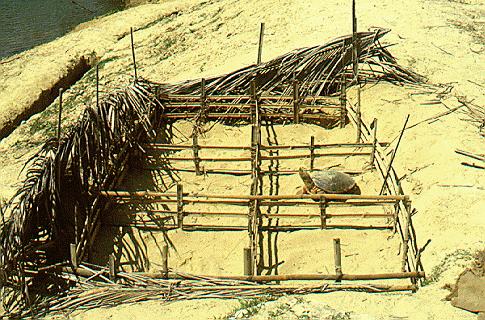Effects of Habitat Alteration on River Turtles of Tropical Asia
with Emphasis on Sand Mining and Dams

|
|
A female painted terrapin, Callagur borneoensis, is shown in a nesting enclosure on the Kedah River of Malaysia. As all nesting beaches on this river have been destroyed by sand mining, female river turtles seeking nest sites are captured by local egg collectors and placed in these sand-filled enclosures until they lay their eggs.
|
EDWARD O. MOLL
Department of Zoology,
e-mail: cfeom@eiu.edu
ABSTRACT: By destroying nesting beaches, sand mining has become one of the most serious factors threatening the survival of tropical Asian turtles. Removal of sand from beaches along Asian rivers to supply construction projects, involving the use of large earth moving equipment, has accelerated over the past two decades. Many rivers are becoming devoid of nesting sites for such sand-nesting chelonians as Batagur baska, Callagur borneoensis, Kachuga spp., Chitra indica, and Pelochelys cantorii. Upriver dams exacerbate the problem by preventing replacement sand from coming downriver while increasing erosion by periodic and unseasonable elevation of water levels. The Kedah River in Malaysia is cited as a case history, exemplifying how the combined effects of sand mining and dams can destroy riverine chelonian populations. Establishment of refuges and zoning of sand mining activities are recommended actions.
Threats to Habitat | Contents Summary |